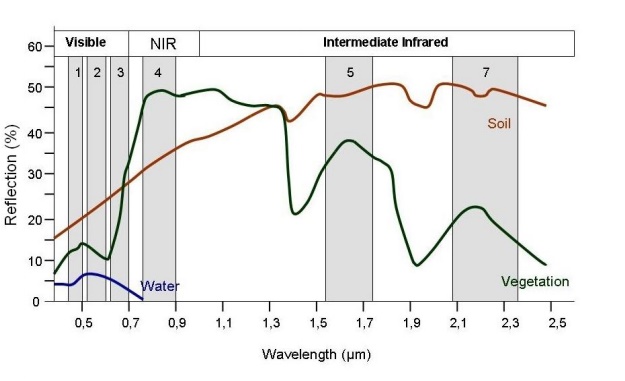Chapter: Civil : Remote Sensing Techniques and GIS : EMR and Its Interaction With Atmosphere and Earth Material
Spectral Signature Concepts Typical Spectral Reflectance Charactristics Of Water, Vegetation And Soil

SPECTRAL SIGNATURE
CONCEPTS-TYPICAL SPECTRAL REFLECTANCE CHARACTRISTICS OF WATER, VEGETATION AND
SOIL:
A basic
assumption made in remote sensing is that a specific target has anindividual
and characteristic manner of interacting with incident radiation. The manner of
interaction is described by the spectral response of the target. The spectral
reflectance curves describe the spectral response of a target in a particular
wavelength region of electromagnetic spectrum, which, in turn depends upon
certain factors, namely, orientation of the sun (solar azimuth), the height of
the Sun in the sky (solar elevation angle), the direction in which the sensor
is pointing relative to nadir (the look angle) and nature of the target, that
is, state of health of vegetation.

Fig 1.8
Spectral reflectance Curve
Every object on the surface of
the earth has its unique spectral reflectance.Fig. 1.8 shows the average
spectral reflectance curves for three typical earth's features: vegetation,
soil and water. The spectral reflectance curves for vigorous vegetation manifests
the "Peak-and-valley" configuration. The valleys in the visible
portion of the spectrum are indicative of pigments in plant leaves. Dips in
reflectance (Fig. 1.8) that can be seen at wavelengths of 0.65 .µm, 1.4 µ m and
1.9 µm are attributable to absorption of water by leaves. The soil curve shows
a more regular variation of reflectance. Factors that evidently affect soil
reflectance are moisture content, soil texture, surface roughness, and presence
of organic matter. The term spectral signature can also be used for spectral
reflectance curves. Spectral signature is a set of characteristics by which a
material or an object may be identified on any satellite image or photograph
within the given range of wavelengths. Sometime&,spectral signatures are used
to denote the spectral response of a target.
The characteristic spectral
reflectance curve Fig1.8 for water shows thatfrom about 0.5µm , a reduction in
reflectance with increasing wavelength, so that in the near infrared range, the
reflectance of deep, clear water is virtually a zero (Mather, 1987). However,
the spectral reflectance of water is significantly affected by the presence of
dissolved and suspended organic and inorganic material and by thedepth of the
water body. Fig. 1.8 shows the spectral reflectance curves for visible and
near-infrared wavelengths at the surface and at 20 m depth. Suspended solids
in water scatter the down welling
radiation, the degree of scatter being proportional to the concentration and
the color of the sediment. Experimental studies in the field and in the
laboratory as well as experience with multispectral remote sensing have shown
that the specific targets are characterized by an individual spectral response.
Indeed the successful development of remote sensing of environment over the
past decade bears witness to its validity. In the remaining part of this
section, typical and representative spectral reflectance curves for
characteristic types of the surface materials are considered. Imagine a beach
on a beautiful tropical island. of electromagnetic radiation with the top layer
of sand grains on the beach. When an incident ray of electromagnetic radiation
strikes an air/grain interface, part of the ray is reflected and part of it is
transmitted into the sand grain. The solid lines in the figure represent the
incident rays, and dashed lines 1, 2, and 3 represent rays reflected from the
surface but have never penetrated a sand grain. The latter are called specular
rays by Vincent and Hunt (1968), and surface-scattered rays by Salisbury and
Wald
(1992);
these rays result from first-surface reflection from all grains encountered.
For a given reflecting surface, all specular rays reflected in the same
direction, such that the angle of reflection (the angle between the reflected
rays and the normal, or perpendicular to the reflecting surface) equals the
angle of incidence (the angle between the incident rays and the surface
normal). The measure of how much electromagnetic radiation is reflected off a
surface is called its reflectance, which is a number between 0 and 1.0. A
measure of 1.0 means the 100% of the incident radiation is reflected off the
surface, and a measure of 0 means that 0% is reflected.
Related Topics